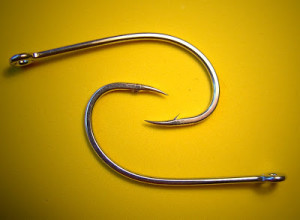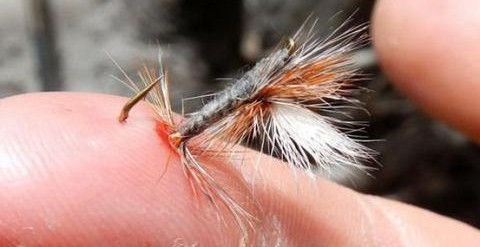
Everyone that has been fishing for any amount of time will eventually come across the topic, should I be using barbed or barbless hooks? Many will use barbed hooks when they begin fishing, usually because 99% of flies, lures, and hooks come with barbs on them, and they never really give it a second thought.
It is only when they are talking to a seasoned fisherman, or perhaps come across a body of water with a barbless hook only policy that the new fisherman will stop and think about what they should use.
There are a number of advantages to using either barbed or barbless hooks. Let’s see which option is best for the type of fishing you are doing.
This post uses amazon affiliate links. I receive commission from any sales at no additional cost to yourself.
Barbless Hooks
There are many arguments for the use of barbless hooks.
Better Hooksets
Barbs actually offer some resistance during the initial hookset by increasing the diameter of the hook. This makes it harder for the hook to penetrate the fish’s mouth, and you have to set the hook harder to ensure the barb is also driven into the mouth of the fish. This is a bigger concern when fishing hooks with larger barbs, or when targeting fish with boney mouths.
There may be a situation in which you have a weak hook set, and the barb is not driven into the flesh of the fish’s mouth. The barbless hook would have been driven deeper due to less resistance in this same scenario. The fish would actually have a harder time throwing the barbless hook in this situation than the barbed hook.
Less Damage to Fish
Barbs hang onto flesh, and create a much bigger wound in the fish when removed. They can often break blood vessels or gills when being removed, which can mean the difference between a successful release and a dead fish.
Compare this to the pinhole created by a barbless hook, which has a much lower chance of damaging something vital.
A deep hooked fish will have a higher chance of mortality than a fish hooked in the lip regardless of type of hook used. That being said, barbless hooks can increase the odds of missing something vital in a deep-hooked fish situation.
Less Damage to YOU.
It’s self-explanatory why you would rather get stuck with a barbless hook. The whole purpose of putting barbs on hooks is to make them harder to remove.
Those same barbs that keep a hook in place on a fish latch onto your own flesh. Pulling out a hook with barbs hurts, and often requires a pair of pliers for larger gauge hooks.
With especially large barbs, the best course of action may actually be to push the hook deeper so it comes out of the skin on the other side and then snip the barb off with wire snippers before removing the hook. Either way, removing a stuck hook is not fun.
If the hook is barbless, it pulls out without any additional pain.
Quicker Hook Removal.
Without a barb, hooks are very easy to remove from fish. Anybody that has spent 5 minutes trying to remove a deep hook from an uncooperative fish will agree that it’s not fun. This is especially true of fish species with bony/toothy mouths or those that are likely to deep hook themselves.
Spending extra time trying to remove a hook from toothy critters such as pike, musky, or barracuda increases your chances of getting sliced by their sharp teeth. A quick and easy release is key to handling these toothy species without getting hurt. Safer for you and the fish.
The less time is spent trying to wrestle a hook out of a fish’s mouth, the more time you can spend actually fishing.
Easier for a fish to remove hook from the mouth if it has broken fly or lure from the line.
If a fish breaks you off with a heavy lure, there’s a good chance that fish will die. That is unless it can successfully remove the lure from its mouth. Many fish species are quite good at removing foreign objects from their mouth, they just need it to be barbless to increase their odds.
Barbed Hooks
There are a few key arguments for having barbed hooks.
Keeps Hook in Place.
This is the whole point of barbs. It does offer extra assurance that the fish will not throw the hook. Once a solid hook set is performed, there’s less chance of a fish throwing a barbed hook than a barbless hook. If you have a moment of slack line, or if you’re new to fighting big fish, it can save you from losing fish.
When bait fishing, hooks do have their place. Often, an angler is not holding the rod when bait fishing. This means they do not have a chance to set the hook immediately. A circle hook paired with a small barb can ensure the fish hooks itself and stays hooked. This is more to do with how a circle hook works than barbs, but it is a situation in which a barbed hook is useful.
Crimp Hooks or Buy Barbless.
Barbless hooks are more expensive. This is because creating the barb is part of the established process in many hook manufacturers machines, so they need new equipment in order to produce barbless hooks.
You can crimp the barbs of each hook individually. This is what I do, but does mean that you have to remember to bring a pair of pliers with you. That, or you could pre-mash all the barbs at home before you go fishing.
It really isn’t that much work to crimp hooks. I probably should crimp them all when I buy them, but that doesn’t happen. Instead I bring a pair of pliers with me and crimp the hooks as I use them. The exception is that when I’m tying my own flies, I always crimp the barb in the vice.
I’ve actually had certain hooks that have broken when attempting to crimp the barb. That tells me the hooks are poor quality and did not purchase those hooks again.

When should I use Barbed vs Barbless hooks?
Barbed hooks
When there are non-target species in the water you are fishing
- When practicing catch and release fishing
- When using large gauge hooks that would hurt to remove if they have a barb
- When there are young, undersized, or oversized fish in the water you are fishing
- When there are protected fish species in the water you are fishing
- Windy conditions. You are much more likely to accidentally hook yourself.
Barbless hooks
- When you intend on keeping the majority of your catch.
- When bait fishing. (Extra tip. Use circle hooks for a better hook up rate on *most* species)
Final Thoughts
Speaking from experience, a firm hookset and minimization of slack in the line are more important to keep a hook in place than a barb is. I’ve switched to using almost exclusively barbless hooks on all my flies and lures, and have not noticed any increase in the amount of fish throwing the hook.
The only fish I still use barbs for are Mackerel and gar. For some reason, mackerel are very good at throwing even barbless trebles. Gar us very small gauge hooks and are also quite adept at throwing barbless hooks so I use them for these fish as well.
Aside from the two species mentioned above, I use barbless hooks 100% of the time. This includes Largemouth Bass, smallmouth bass, trout (rainbow, brown, and brookies), pike, musky, walleye, carp and many other species.
I used to waste so much time removing a barbed hook from a fish’s mouth (especially with winter flounder), that it resulted in a significant reduction in time actually fishing. Imagine you are fishing striped bass at dawn on an outgoing tide. You do not want to be wasting precious time wrestling barbed hooks out of little schoolies. Barbless hooks allow you to release these small fish quickly and allows you to get back to the matter at hand; catching a monster striper! Of course, by using barbless hooks, all those schoolies you are catching are much less stressed and more likely to survive and grow into monsters themselves.

3 thoughts on “Barbed vs Barbless hooks”